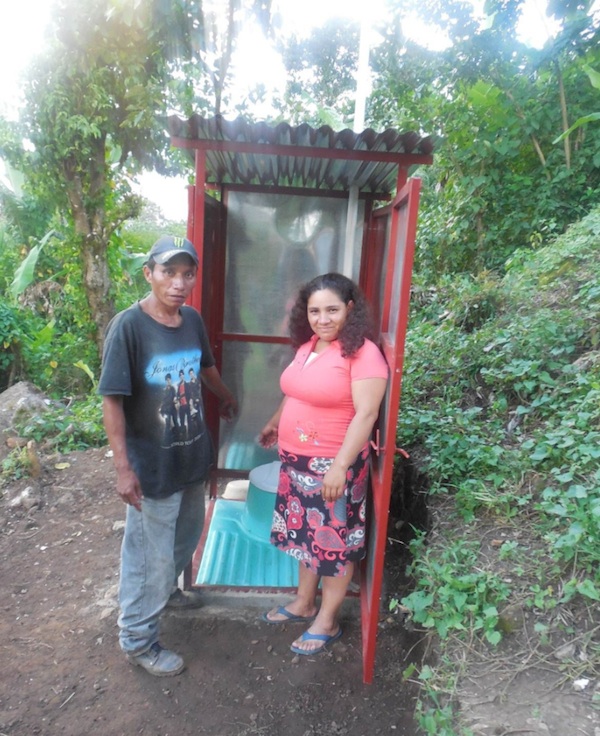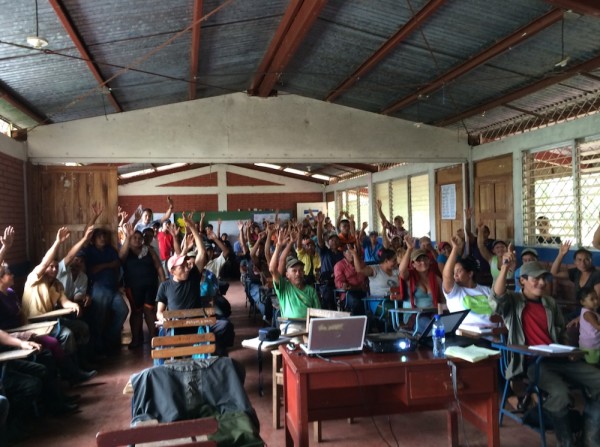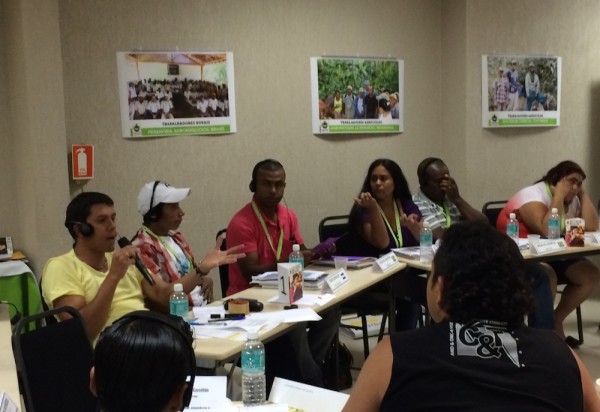In the United States for the first time in his life, lifelong coffee farmer Marcos Camil of Ipanema Agricola in Brazil stopped into a Starbucks last weekend during the SCAA show in Seattle.
“The price one coffee we drank there was one day of labor at the origin,” Camilo (translated from Portuguese) later told guests at an SCAA panel discussion on how farmworkers are traditionally excluded from the coffee industry’s supply chain sustainability efforts. In a somber voice, Camilo noted how coffee appeared to be “green gold” during his visit, a complete contradiction to his daily experiences in coffee farming since the age of 13. “Most times we are not aware of values and negotiations…We are not aware of the value the product has.”
(more: It’s the Market, Stupid: Why We Need Greater Farm-Level Incentives)
This is a prime example of supply chain disfunction, where at one extreme is a $4 latte, and at the other are farmworkers — not necessarily smallholders or cooperatives or individual farms, but the actual humans that pick the majority of the coffee consumed in the world — afflicted with widespread poverty, food and work insecurity, child labor, and little or no access to healthcare or basic education.
Despite the amazing work of some buyers within the industry over the past decade to strengthen sustainability within their own supply chains, as well as the work of nonprofits and other NGOs to provide direct relief at origin, the coffee industry on the whole has a serious and growing “farmworker problem,” suggested Michael Sheridan of CRS Coffeelands, who moderated the panel discussion “Millions on the Margins: Bringing Farmworkers Into Mainstream Sustainability Efforts.”

This toilet was built by farmworkers for farmworkers, creating an essential service but also a sense of empowerment. Photo by Jose Acuna.
“The first step to solving a problem is realizing that you have one,” said Sheridan, adding that our “collective IQ” on sustainability issues affecting smallholders is much higher than it is on actual farmworkers. “Farmworkers remain largely invisible in the sustainability discourse in our industry.”
(more: From the ‘Rape Capital of the World,’ A Story of Coffee and Hope)
This largely blind eye from the majority of the coffee industry is in itself is not sustainable, suggested Erik Nicholson of United Farm Workers, who came to the panel with decades of experience working to identify and resolve labor issues in a number of agricultural sectors. “Things are getting worse and they’re getting worse fast,” Nicholson said of working and living conditions for farmworkers. “In an industry that produces so much wealth, we should be appalled.”
As the only panelist representing buyer side of the industry, Pascale Schuit of London’s Union Hand Roasted Coffee announced her full support of promoting this conversation, sharing her own appalling experience on what her first trip to a coffee farm. She lived there for 30 days, witnessing cruel realities such as farmers leaving babies in the field among snakes and scorpions while they worked, and children in the field with untreated mental disabilities.
These examples do not exist in isolation, Schuit said, but are common symptoms of a broken supply chain. “This is happening,” she said. “We cannot close our eyes and look the other way.”
In an appeal to leaders within the industry, Fair Trade USA Director of Coffee, Innovation and Producer Relations Miguel Zamora said the living and working conditions among millions of farmworkers are primarily ethics and sustainability issues, but they also happen to be “a public relations disaster waiting to happen.” Zamora cited the negative public relations outbreak related to widespread child labor and slavery in the cocoa industry, suggesting coffee might be next.
Zamora and Fair Trade USA reached out to Camilo to visit SCAA, in part to help put a human face on farmworker issues, but also to discuss the group’s Fair Trade For All program, of which Camilo’s Ipanema Agricola has been a pilot member. Unlike other programs at origin that provide direct relief, certification implementation or labor organization assistance, the program takes a unique approach toward communication: Farmworkers gather for workshops and discussions through which they collectively define their greatest needs, either in the field or at home. Then, with funding assistance, farmers are involved in planning, building and implementing the projects themselves, creating not only essentials like drinking water, daycare facilities or toilets, but also a sense of empowerment.
(more: Nonprofits Banking on Beekeeping to Help Farmers in the Thin Months)
Part of the program involves bringing farmers together from other farms and countries to also collectively share issues and insight. Said Zamora, “We can’t create sustainability for workers, we have to create sustainability with workers.”
All panelists agreed that certifications of many kinds can be a useful tool in addressing the “farmworker problem,” but that they can only go so far in long-term sustainability. For now, they said, the responsibility must also fall on industry to help bring farmworkers into the sustainability discussion.
For Camilo, new toilets on his farm, built by farmers, are a sign of hope. So too was the fact that his farmer friends in Nicaragua received a deal for a premium contract during the SCAA show. But his discovery of “green gold” in Seattle was anything but encouraging.
Said Camilo, “The people on my farm… When I go back to Brazil and share this reality with them, there will not be smiles.”
Nick Brown
Nick Brown is the editor of Daily Coffee News by Roast Magazine.
Comment
9 Comments
Comments are closed.








Hi Nick,
Thanks for the story. I found it informative and sobering. I wonder if the economics of buying and trading coffee will ever mean enough money get back to the farmers and workers who, alongside the roasters and baristas, are the ones who actually add value to the coffee equation!
As someone who is not privy to the workings of the coffee supply chain, I am really interested to know how much money farmers get for their coffee, and how much mark-up takes place in between them and the end consumer. I imagine there is a substantial mark-up at the retail stage, but what about the rest? It would be great to have that insight.
D. Ling, you ask the $64,000 question: what IS the farmgate price of coffee in the case of growers, and how much of that is passed on to workers in the form of wages? I think most people would be surprised to know how few coffee brands/roasters understand farmgate prices to growers/wages to workers.
I do know of a few remarkable roasters that are working to systematically map the creation of distribution and value in their own supply chains through participatory processes. This exercise is not motivated exclusively or even necessarily primarily by concern about growers and workers–it also serves to sharpen competition among supply chain actors for more efficient delivery of services and returning a greater share of coffee’s value to source. One roaster I know requires its exporters to deliver 85% of the FOB price to growers and finds new partners if its exporters can’t produce evidence to show they comply.
Sadly, these are the exceptions rather than the rule. Even Fair Trade, which mandates minimum FOB prices, doesn’t have any requirements for price transparency or minimum farmgate pricing.
Michael
Thanks for writing about such an interesting and important topic, Nick! I really appreciate the exponentially greater amount of attention given to farmworkers at this year’s events compared to other years and I’m enjoying reading different perspectives.
What compels me to comment, however, has less to do with farmworkers than the way that we sometimes frame issues of poverty, food and work insecurity and child labor, among others. I couldn’t agree more that this is, as you put it, a “prime example of supply chain dysfunction”, but I cringe at the phrase that follows it because I don’t think a $4 latte is extreme at all. In fact, I think a latte probably should cost MORE than four dollars, especially if we want to address not only the issues of coffee farmworkers but also of dairy farmworkers (as a side note, I had a conversation with industry-leading dairy farmers at Symposium who unanimously agreed that the biggest threat to their sustainability efforts right now is the nightmarish state of US immigration law). Poverty in the supply chain is unacceptable no matter what prices we sell our product for and I hate to think that anyone might read an article like this one with so much to say about the issues we face and infer somehow that their morning coffee – whether that’s straight espresso or a venti caramel macchiato – should be cheaper.
Kim, you make an excellent point and I thank you for writing. Perhaps “extreme” was the wrong word, and “end” might have sufficed. It was not my intention to suggest that a $4 latte was a problem in and of itself. I merely meant to underscore Mr. Camilo’s perception of value, to juxtapose the $4 at one end of the chain (latte) with the $4 at the other (more than a full day’s worth of labor). I don’t know that the collective consumer response to awareness of poverty among huge numbers of coffee farmers would be, “then we need to pay less for our coffee.”
Thank you for bringing the poor word choice to my attention.
Hi Kim Elena,
We published a post from Michael Sheridan this morning that I think fully supports your comment:
http://dailycoffeenews.com/2014/05/05/why-and-how-coffee-can-command-more-value-from-consumers/
Thanks again for helping bring some perspective to the conversation.
Hi, Nick!
Thank you for replying so thoughtfully to my comment last week and for alerting me to Michael Sheridan’s post today. I appreciate your work here and I’ll keep reading!
Thanks, Nick and Roast Magazine for highlighting this discussion and panel. Just as Michael mentioned during the session, it is the first time since I am involved in coffee that farm workers have been mentioned and their challenges and opportunities have been discussed at the show. Thanks, SCAA and its councils/committees, for giving that space/opportunity this year.
Thank you Fair Trade USA and Mr. Zamora for continuing to shine a light on the plight of farm workers and their families and communities. I think the $4 example is excellent. The dollar amount is arbitrary. That latte could be $3 or could be $5. I think a good takeaway is the fact that it sparked Mr. Camilo and others to ask themselves “what is the value of my labor ?”, “are we entitled to fair wages and safe working conditions?”, “if others value our product so greatly, are we justly compensated ?” and other related questions. It also helps to put “wealth” and “poverty” in perspective. The average day’s wage in the United States is about $150. Imagine a very common beverage in most countries costing $150 for 12 ounces.
For some time we have known that coffee farmers live on the world’s richest land yet cannot properly feed their families. That is what motivated Specialty Coffee to make an unprecedented effort toward sustainability in the last generation. The results may have been sketchy, but the original intent was there. But, sustainability cost money, so naturally, as business paid the bills, sustainability drifted from within the missions of many organizations to the marketing departments.
The marketing of sustainability evolved into cause marketing, which was basically a sales tool. Later, it seemed a good fit for sustainability to be linked to the supply chain, connecting sustainable programs to the access of a fluid line of supply. More recently, the direct trade movement evolved. Buying at premium prices appeared to be both sustainable for farmers and ensure a line of supply for high quality coffee. Unfortunately, sustainability at origin is far more complicated than all of the above. The hard reality is sustainable development is not just about money and cannot be delivered from the top down. Nothing grows from the top down.
Sustainable development must come from farmers, not from NGOs, nor from coffee buyers. The former can facilitate opportunities, but not direct them. The latter is loaded with conflicts. That said, NGOs and buyers have a serious role to play. They can support and facilitate appropriate development. But, farmers need to do it.
Appropriate development is when farmers learn from each other. When this occurs, they learn from someone just like them. Someone who speaks their language, uses their expressions, and understands their lives, their challenges and their land. Lessons learned from each other are far more digestible than those learned from an outside or even local NGOs or coffee buyers.
The Campesino a Campesino methodology (farmer to farmer) empowers farmers not only with the skills to improve their lives, but with the power to teach others. Farmers train beneficiaries. Beneficiaries become trainers. And so it goes. It’s not sexy development. It takes time. It takes patience. It takes commitment and it takes faith. It’s easy to criticize, as it can be a little messy. But, over the long term, it can be very effective.
Over the last generation, the specialty coffee trade has made extraordinary gains in the area of sustainability, an area that had been totally ignored in generations past. It should be no surprise that the movement has not been perfect. The trade did what it knew how to do. It may have been clumsy, but it brought issues that had never been part of the coffee equation to the front of the industry.
As far as the $4.00 latte is concerned, labor costs, taxes, insurance rent, utilities and even milk are far more at work in that cost than the coffee. It is far too easy to blame the coffee trade for the discrepancy when other factors are far more relevant. That said, the structure of our trade somehow allows farmers to be treated as a business variable rather than be treated as human beings. Here the $4.00 latte can be a gift. If consumers are willing to pay all the utility costs in a $4.00 latte, surely they would pay a little more to help coffee farmers improve their lives. It just requires a little honesty from purveyors.
Of course, to do this, consumers must be treated with respect, not just sold sound bites on coffee packaging. It may not be easy to talk honestly to consumers about the reality of life at origin. However, it is the truth. And, when coffee merchants tell the truth to their consumers, consumers will reward them not only with support for sustainability, but also with increased sales. The reality is we need to take sustainability out of our marketing departments and bring it back to our missions.
It’s a long road to sustainability. There are no shortcuts.